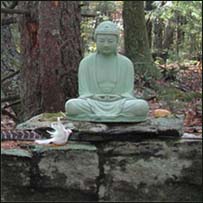|
|
 |
Please support Dharma Seed with a 2025 year-end gift.
Your donations allow us to offer these teachings online to all.

|

|

|
The greatest gift is the
gift of the teachings
|
|

|
| |
|
Dharma Talks
|
2017-01-05
What Channel Are You Tuned To?
50:52
|
|
James Baraz
|
|
|
(Note: This talk has some occasional sound distortion but it's worth it.)
As the Buddha said, "We are what we think. With our thoughts we make the world." Our minds can go to the the greatest places of fear, anxiety and ill will or understanding, compassion and peace. When we're lost in confusion we have in us the capacity to remember the goodness and wisdom that our hearts long to connect with. This talk is about remembering that possibility and cultivating access to that Buddha right inside, especially when the outside world is giving us very different messages.
|
|
Insight Meditation Community of Berkeley
:
IMCB Regular Talks
|
|
|
2017-01-03
The Wound that Seeks the Arrow
57:45
|
|
Ajahn Sucitto
|
|
|
Ajahn Sucitto explores the unskilful tendency to create an "I am" with reference to mental programs (sankharas), despite the unwholesome effect that this identification creates. We can learn to release the process between perception and activation so these programs no longer have a place to stand
|
|
Villa St Martin Centre
:
Montreal New Year 2016-17 Retreat
|
|
|
2016-12-31
Die große Stille
47:10
|
|
Renate Seifarth
|
|
|
Nibbana, Befreiung ist das Ziel der Praxis. Was ist Nibbana? Buddha beschrieb das Ziel des Weges als das Aufgeben von Anhaften. Wenn Haften und Reaktivität erlöschen, wir innerlich loslassen und eintauchen in ein offenes Dasein, können wir eine tiefe Stille erleben. Oft übersehen wir die Stille, weil wir auf etwas anderes warten, einen Bigbang, etwas Außergewöhnliches. Nibbana können wir aber hier und jetzt erfahren, in den Momenten, in denen unsere Reaktivität erlischt und eine lebenige, offene Stille sich in uns ausbreitet, in der alles sein darf wie es ist.
|
|
West Germany
:
Neujahreskurs 2016/17
|
|
|
|
|